- News
- Reviews
- Bikes
- Components
- Bar tape & grips
- Bottom brackets
- Brake & gear cables
- Brake & STI levers
- Brake pads & spares
- Brakes
- Cassettes & freewheels
- Chains
- Chainsets & chainrings
- Derailleurs - front
- Derailleurs - rear
- Forks
- Gear levers & shifters
- Groupsets
- Handlebars & extensions
- Headsets
- Hubs
- Inner tubes
- Pedals
- Quick releases & skewers
- Saddles
- Seatposts
- Stems
- Wheels
- Tyres
- Tubeless valves
- Accessories
- Accessories - misc
- Computer mounts
- Bags
- Bar ends
- Bike bags & cases
- Bottle cages
- Bottles
- Cameras
- Car racks
- Child seats
- Computers
- Glasses
- GPS units
- Helmets
- Lights - front
- Lights - rear
- Lights - sets
- Locks
- Mirrors
- Mudguards
- Racks
- Pumps & CO2 inflators
- Puncture kits
- Reflectives
- Smart watches
- Stands and racks
- Trailers
- Clothing
- Health, fitness and nutrition
- Tools and workshop
- Miscellaneous
- Buyers Guides
- Features
- Forum
- Recommends
- Podcast
£2,500.00
VERDICT:
Brilliant do-it-all bike. Light, tough, very well-specced and grin-inducing
Weight:
8,730g
Contact:
At road.cc every product is thoroughly tested for as long as it takes to get a proper insight into how well it works. Our reviewers are experienced cyclists that we trust to be objective. While we strive to ensure that opinions expressed are backed up by facts, reviews are by their nature an informed opinion, not a definitive verdict. We don't intentionally try to break anything (except locks) but we do try to look for weak points in any design. The overall score is not just an average of the other scores: it reflects both a product's function and value – with value determined by how a product compares with items of similar spec, quality, and price.
What the road.cc scores meanGood scores are more common than bad, because fortunately good products are more common than bad.
- Exceptional
- Excellent
- Very Good
- Good
- Quite good
- Average
- Not so good
- Poor
- Bad
- Appalling
The Renegade is a brand new model for 2015 from US brand Jamis, tapping into the growing market for adventure road bikes, adept on the road but also capable off it.
As soon as we saw the first details, we set to pestering Evans (which has the exclusive rights to Jamis to the UK) to send us one. Sure enough, we managed to get one of the first examples into the country, and I've spent the last couple of months trying to find the limits of its considerable talents.

Buy this bike online here
Find your local store here
With an intoxicating combination of road lightness and trail toughness plus Shimano's stunning hydraulic disc brakes and a great wheel and tyre package, the Renegade offers excellent (if relaxed) road manners and is outrageously good fun off the beaten track. It'll go further and harder off-road than any other road bike I've ridden, in fact, with a depth of off-road ability that is simply astonishing. But don't mistake it for a simple mud-plugger with drop bars. A change of tyres is all that's needed to use it for fast all day road rides or even chaingang lung-busters. Leaving no boxes unticked, it also takes mudguards and a rack, and can accommodate tyres up to 40mm. In short, it's an absolute belter.
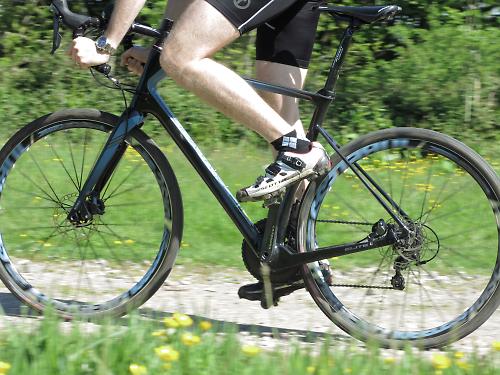
There are two versions of the Renegade – the Elite (which we tested) and the Expert, which – at £1,400 – is over a third less. Neither are what you'd call cheap bikes, but for what you're getting, both are great value. Particularly as – presumably for reasons of currency fluctuation – they are cheaper in the UK than in the US – not something we're accustomed to seeing. We'll be focusing on the Elite version as that's what Evans was kind enough to send us, but we'll look at how the Expert differs too.
Buyers Guide to Disc Braked Road Bikes
Frame and fork
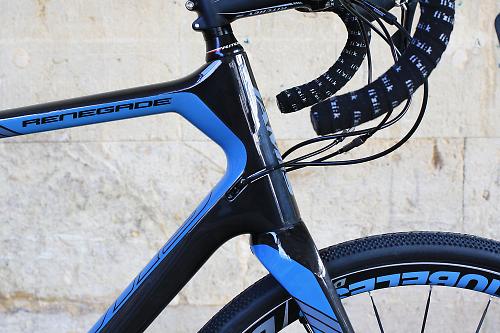
The Renegade Elite has a full carbon monocoque frame and fork, built using high-modulus Omniad M30 carbon fibre and using Jamis's Near Net moulding process. This uses a combination of silicon and polystyrene internal moulding parts to ensure that the inner surface of the monocoque is smooth. Most manufacturers now use similar techniques, with the goal of keeping weight low and strength high through the elimination of any internal stress raisers. The lower-priced Expert model uses a different grade of carbon, (mid-modulus Dyad Plus T700/FRP), resulting in a frame weight that's a little higher than here. Jamis quotes all-up weights of 8.06kg for the smallest Elite and 9.54kg for the equivalent Expert. That's quite a big difference, also attributable to the use of a lower-rung groupset and more basic wheels. Our 58cm Elite weighs a very respectable 8.7kg on the road.cc scales, which is impressive – we've tested several road bikes with disc brakes and no off-road aspirations in the last year which are similar weights.
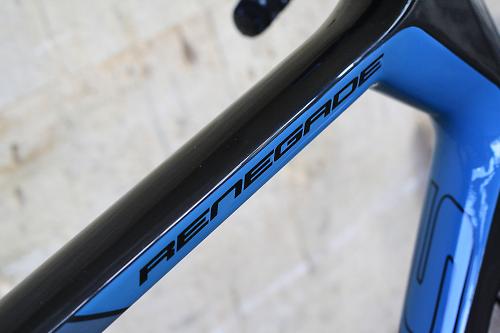
There are six available frame sizes, from 48 up to 61, with the diameters of the tubes being different from one size to the next – 'Size Specific Tube tuning' – designed to give consistent ride characteristics across the range of sizes. Jamis doesn't stop there, however, also changing the bottom bracket drop and chainstays lengths across the size range. Using three different fork moulds means that Jamis can maintain the desired fork trail despite the head tube angle varying from 70.5 degrees on the 48 up to 72.5 degrees on the 61. Seat tube angle is 73 degrees across all sizes.
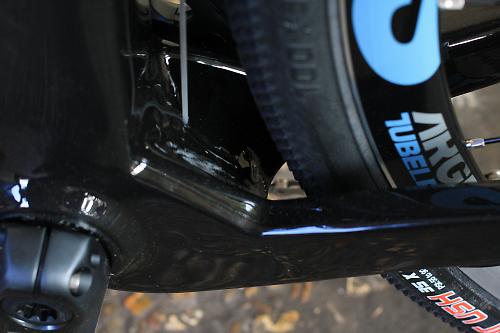
The down tube and top tube are chunky angular sections, and the bottom bracket housing is huge, comfortably swallowing the FSA BB386EVO bearings. Looking rather unusual, the beefy asymmetric chainstays exit markedly below the bottom bracket centre, with this intended to give greater tyre clearance. By contrast the seat stays are fashionably thin and flattened, joining the seat tube a few inches below the junction with the top tube. Jamis says that without the need to mount a brake calliper here, it had greater leeway to tune the compliance in the seat stays without worrying about braking forces.

It works too, with the rear offering a decent level of compliance over bumps and cracks in the road. At the front, the fork uses Rockshox's 15mm Maxle screw-in axle, offset behind the fork legs to provide a small amount of vertical compliance. (There's a standard QR at the rear.) This arrangement is what Jamis calls ECO – Enhanced Compliance Offset. It is less compliant than at the rear, however, with this impression seemingly exaggerated by the rattling of the cables and hydraulic hoses over bumpy terrain. I found this annoying, actually, and used some Jagwire cable clips to stop the racket.
With road tyre pressures, the Renegade doesn't cosset you on bad roads in the same way that a carbon Giant Defy or Trek Domane does, but this is necessarily a burlier machine than either of those. The stock 35mm tyres are a pointed hint that this is a bike that can cope with rather more than a jaunt along a canal path. More on those tyres later.

When I first threw a leg over the Renegade, the impression was of it being quite a large 58. The effective top tube is 586mm, but it's probably the tall front end that contributes most to this impression. Slamming the stem only goes so far; a 202mm headtube and the big tyre clearance meaning that it's no wind-cheater. Aerodynamics are obviously not the primary goal here, and the tall front end is helpful when you're hammering down a rocky bridleway on the drops. Here the long wheelbase helps too – 105cm on the 58 – giving quite exceptional stability.
On the road this makes for handling that is reasonably relaxed – it's certainly not rapier-sharp like a crit bike but neither is it a barge – and off-road it gives you a bit more leeway to push the limits before you run into trouble. One-handed braking, when you need to indicate a turn and you're going too fast to make it round, is supremely unchallenging; less stressful than any other bike I can think of, in fact. The sheer efficiency of the hydraulic brakes undoubtedly helps here too.
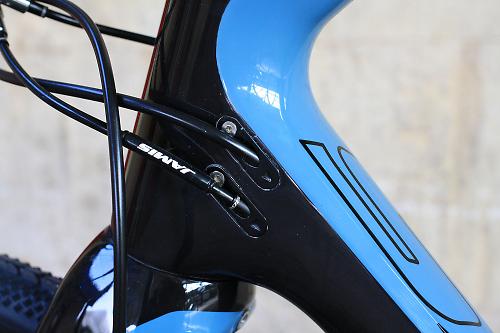
There's full internal cabling on the frame (although the front brake hose doesn't pass inside the fork) and it's Di2 compatible, allowing for future upgrade. There are a couple of other unusual details to point out. The bolts which hold the brake callipers in place screw into perpendicular metal pins which slide into the frame and fork from the side, rather than into fittings moulded into the carbon. Jamis say that this is to remove the risk of in-moulded fittings coming loose when heated by heavy braking. Viewed from the front, the fork legs are noticeably asymmetric, with the lower left leg being thicker in order to deal with the brake forces.
Little metal eyelets screw into the bottom of the fork and the corner between the seatstays and chainstays, allowing mudguards and a rack to be fitted. Apparently some people object to the aesthetic impact of conventional eyelets on a performance bike; I can't say I'm one of them, but the eyelets are a novel solution for those who are concerned by such things.
Fitting a front mudguard can be complicated by the presence of the disc brake – in the end I knocked up a custom bracket to fit much-shortened left stays to the brake calliper mount. The shape of the fork means that the eyelets are below and in front of the axle, so you'll likely need the full length of the wire stays to reach the right-hand mounting point.
At the rear, Jamis tell me that the frame and eyelets were tested with a 25kg load, typically the maximum for all but heavy-duty touring racks. The rack's upper stay has to attach to the tapped hole on the front of the brake bridge, which like the eyelets has to double up if you're also using mudguards. You can buy an adaptor which attaches to the brake bridge and makes rack mounting easier, or you can just do what I did and bend one of the rack's stainless strips to fit.
Equipment - very well thought out selection
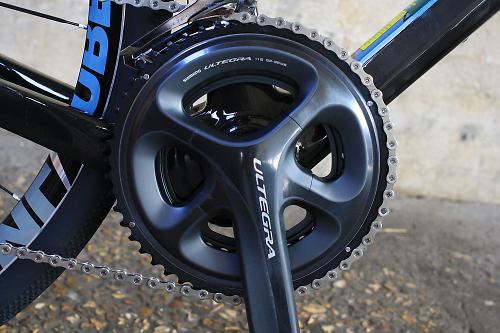
The Renegade Elite is very well kitted out, with a full Shimano Ultegra 22-speed groupset being a decent starting point. There's a wide 11-28 cassette paired with the fashionable pro-compact chainset (52/36), a halfway between a traditional standard chainset and a 50/34 compact. This gives a great spread of gears for road use, but on steep off-road climbs I sometimes found myself wishing for either a 34t chainring, a 32t sprocket or both. Swapping chainrings (to compact or standard sizing) is possible thanks to Shimano now using a common bolt circle diameter between the various sizes. Shimano cranks use a 24mm axle, so Delrin Wheels Mfg adaptors are used to fill the 30mm bearings specified by the press-fit BB386EVO standard.
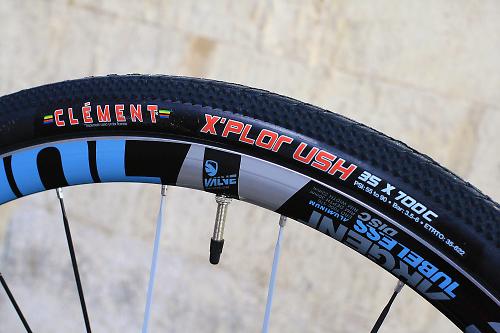
As we've reported previously, Shimano 6800-series Ultegra is a superb groupset, giving slick shifting up and down even under power. When it's my money, I tend to buy SRAM, but I was really impressed with this latest iteration of Ultegra. It's so effortlessly smooth and efficient, with crisp changes at the rear and gloriously lightweight yet precise changes at the front. The otherwise excellent non-series R685 shifters only allow two upshifts at a time at the rear – a constraint of having to package in the hydraulics, we assume.

Besides the frame, one of the key components here is the brakes. We've rhapsodised about Shimano's BR685 discs already, with the clarity and efficiency of hydraulics making controlled braking significantly easier and less tiring than even the best calliper brakes. I used an early Di2 version of these brakes on the road before, and this latest version with the mechanical shifters seems noticeably better dialled in.
On the road, this translates into an intimate relationship between the lever and the brake. Oil gives an effectively frictionless transmission of braking effort, and this makes it easier to judge your braking. Ultimate deceleration is still limited by the grip between your tyres and the road, of course, but being able to apply just the right amount of braking instantly and with this much clarity gives huge confidence when descending at speed. Once you're used to these brakes, getting back onto a rim-braked bike leaves you wondering how you ever thought that was what good braking felt like.

Off road it makes arguably an even greater difference. The power and efficiency of braking available means that one-finger braking is always enough, on any surface, any gradient and at any speed. This liberates the rest of your digits to hang on to the bars and keep the bike going where you want. The front end is directionally very stiff, doubtless enhanced by the fitment of a thru-axle and the tapered headset, and even hitting roots at speed doesn't send it far off-course.
American Classic Argent wheels are another real highlight, with their lightweight toughness suiting the bike perfectly. They're tubeless compatible although the supplied tyres aren't, but it's nice to have the option without changing wheels. The rims are 30mm deep, giving a minor aerodynamic benefit at speed, and they're wide too – 22mm external / 19mm internal, making them a stable platform for wider tyres.

List price on these wheels is a hefty £899 - that's serious money for a £2.5k bike. I couldn't find another similarly-priced adventure road bikes with wheels of remotely this calibre. They're seriously light too, at 1530 grams, with the sub-400g rim weight (yep, less than Mavic Ksyrium Elites) making them quick to accelerate when fitted with road tyres. With the supplied tyres, they've taken a pounding off-road during testing and remained true – very impressive. The wheels are colour-coordinated with the frame and have some rather shouty graphics which will probably divide opinion. In any case these are a fantastic set of wheels (arguably warranting a review all of their own).
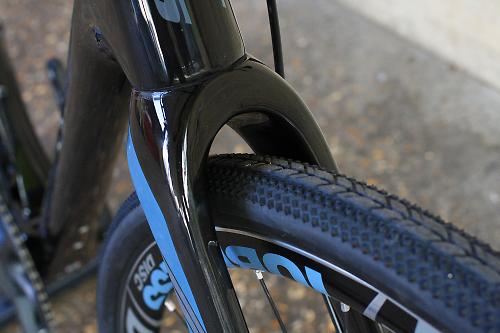
As I mentioned, the tyres aren't tubeless compatible, but they are excellent in most other respects. Jamis opted for the 35mm X-Plor USH model, a 60tpi folding tyre from Clément. Whereas in Mavic-speak UST signifies a tubeless rim design, USH here is the airport code of Ushuaia in Argentina. Of course. All Clément tyres are named after airports, it turns out, and apparently Ushuaia is 'the ultimate destination for adventure bike touring'.
I'll readily admit that I'd expected to switch them out pretty sharpish for something smaller, lighter and more road-focused but they roll surprisingly well on tarmac. The near-continuous centre tread is the key to this, with diamond knobs on the shoulders of the tyres designed to help grip when cornering on loose surfaces. Over the test period I found that there was visible wear on the centre section, so if you're doing high mileage on the road you'd probably want something road-specific. At high pressures they are less supple than some tyres, likely because of the relatively low thread density and the thickness of that central section of rubber.
They're at their best when you drop the pressure, giving loads of compliance from the large air volume; for road use I ran around 50-60psi and used them for rides of 100km or more without feeling they were really slowing me down too much. Off road I went as low as 30psi, with the wide rims helping to keep them stable even at lower pressures. Weighing 350g each, they're not the heaviest 35mm tyres, but obviously there's scope for a decent saving in weight and rotating inertia by fitting road tyres for when you know you'll be staying on the straight and narrow. If you're heading in the other direction, the frame and fork will accommodate up to a 40mm tyre.
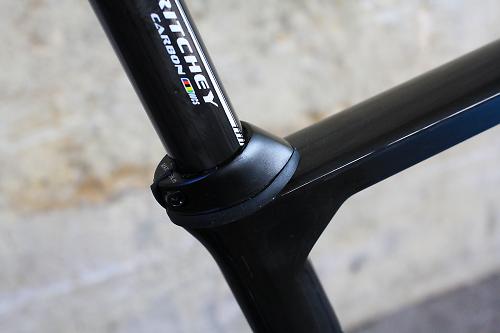
The stem, bar, seat-post and saddle are all from Ritchey. The carbon Flexlogic post uses a special layup to add some extra compliance, but it's a chunky 31.6mm post so it doesn't move as much as a thinner one would, and the aluminium Comp bar and stem are relatively low-cost but worked just fine. Fizik's Superlight bar tape is a tough and reasonably comfortable choice, and although I would have opted for something with a bit more padding, this would be easy to remedy.
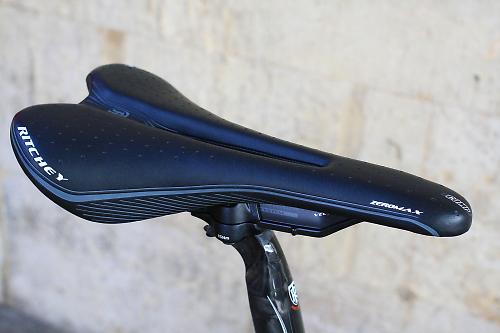
The saddle is the ZeroMax Comp which uses Ritchey's Vector Evo rail mount system. Ritchey says that this moves the mounting points away from the sit-bones to enhance comfort. It's a decent saddle which I got on reasonably well with. If it doesn't suit you, Ritchey can supply clamp adaptors allowing you to fit conventional saddles without needing a whole new seatpost.
Spec Downgrades on the Renegade Expert
The Expert model costs significantly less, and as you'd expect there are some spec downgrades needed to make that possible, as well as the lower-grade carbon used in the frame. Gone are the full hydraulic brakes, although TRP Hy/Rd brakes are the closest you can get with cable actuation. 11-speed Shimano 105 replaces Ultegra, and there's a much lower-cost wheelset with Alex tubeless-compatible rims on Formula hubs. The saddle and seat-post are also downgraded.
Conclusion

Right now, if I had could only have one bike, this would be it. Finding the limits meant taking it to almost ridiculous extremes. Downhilling bridleways with a rack and pannier? Sure – just drop some tyre pressure to maximise grip and revel in the sublime control and braking. Chaingang? Sure, just change the tyres and you'll be fine. Climbing rock-strewn trails? Not a problem, thanks to the low weight and brilliant tyres. Successive long days of touring with a rack? Tick, and in reasonable comfort too.
The frame and fork are brilliantly well-judged, light enough for road use and tough enough to thrive off the beaten track. Shimano's hydraulic brakes are every bit as good as everyone's told you, and the rest of the Shimano bits worked flawlessly. Astutely-chosen tyres and a primo wheelset complete the picture.
The pricing makes this bike terrific value. A lot of the major brands have brought out adventure road bikes this year and none that I've seen are as well-specced for the money. As an example, Specialized has a similar sort of model, the Diverge Expert Carbon, which is $4k in the US and £3k here (with carbon frame, Ultegra, Shimano hydraulics and much more basic wheels). The Jamis is $4.2k in the US and £2.5k here – bargain!
Verdict
Brilliant do-it-all bike. Light, tough, very well-specced and grin-inducing
road.cc test report
Make and model: Jamis Renegade Elite
Size tested: 58 cm
About the bike
State the frame and fork material and method of construction. List the components used to build up the bike.
Carbon monocoque frame and (Maxle) fork. 22 speed Shimano Ultegra with BR685 hydraulic disc brakes. American Classic Argent Tubeless wheelset. Clément X-Plor 35mm tyres. Ritchey finishing kit.
Frame and fork
Overall rating for frame and fork
9/10
Tell us about the build quality and finish of the frame and fork?
Very well finished, sturdy and lightweight.
Tell us about the materials used in the frame and fork?
Omniad M30 Monocoque Carbon Fibre
Tell us about the geometry of the frame and fork?
Relatively tall as befits a bike for on and off-road. 58cm model has 396mm of reach and 620mm of stack, 72° head tube angle, 73° seat tube angle and an effective top tube of 586mm.
How was the bike in terms of height and reach? How did it compare to other bikes of the same stated size?
It felt big initially, although once I'd slammed the stem I was more comfortable.
Riding the bike
Was the bike comfortable to ride? Tell us how you felt about the ride quality.
Comfort was good, especially when running with low tyre pressures (unsurprisingly). The frame and fork don't have the same degree of isolation as bikes such as a carbon Giant Defy or Trek Domane.
Did the bike feel stiff in the right places? Did any part of the bike feel too stiff or too flexible?
Very stiff at the BB for good power transfer. It was quite vertically stiff at the front, but that's a fair price to pay for the abundance of off-road control. Unless you have no interest in ever riding off-road, in which case this maybe isn't the right bike for you.
How did the bike transfer power? Did it feel efficient?
Very efficient – chunky main tubes and a huge BB make this transfer power very well.
Was there any toe-clip overlap with the front wheel? If so, was it a problem?
None – you'd need flippers for this to be a problem with the 105cm wheelbase.
How would you describe the steering? Was it lively, neutral or unresponsive? It is relatively relaxed. This is perfect for the range of use it's designed for and gives tremendous stability. It's not a crit bike.
Tell us some more about the handling. How did the bike feel overall? Did it do particular things well or badly?
Relaxed handling doesn't make it a boring bike – I really enjoyed riding this quickly on the road. Offroad it is simply stunning.
Which components had the most effect (good or bad) on the bike's comfort? would you recommend any changes?
Tyres are probably the biggest contributor together with the frame itself; they're best run at relatively low pressures. I'd fit thicker bar tape.
Which components had the most effect (good or bad) on the bike's stiffness? would you recommend any changes?
Maxle front axle undoubtedly helps and the wheels are excellent in this respect.
Which components had the most effect (good or bad) on the bike's efficiency? would you recommend any changes?
Pedalling efficiency is good, aerodynamic efficiency isn't its strongest suit as it's fairly tall.
Rate the bike for efficiency of power transfer:
9/10
Rate the bike for acceleration:
8/10
Relative to its peers, it accelerates very well. It's obviously no match for a 6kg race bike.
Rate the bike for sprinting:
8/10
Rate the bike for high speed stability:
10/10
Rate the bike for cruising speed stability:
10/10
Rate the bike for low speed stability:
10/10
Rate the bike for flat cornering:
8/10
The big tyres and long wheelbase mean that cornering on the road isn't precise like on a race bike, but with smaller slicks it's good enough.
Rate the bike for cornering on descents:
10/10
I've decided to mark this category primarily for off-road cornering (which doesn't have its own category. I'd give it an 11 if I could.
Rate the bike for climbing:
9/10
Climbs very well on and off road.
The drivetrain
Rate the drivetrain for performance:
10/10
Shimano isn't normally my first choice but Ultegra is basically flawless.
No issues, too soon to give a mark for this I feel.
Rate the drivetrain for weight:
9/10
SRAM Force is lighter, but Ultegra ain't heavy.
Rate the drivetrain for value:
9/10
Full Ultegra with hydraulic discs is great on a bike at this price.
Wheels and tyres
Rate the wheels and tyres for performance:
10/10
Rate the wheels and tyres for durability:
8/10
No brake track to wear out and no trueing needed during testing. Tyres wear quicker than road tyres when used on tarmac.
Rate the wheels and tyres for weight:
10/10
Rate the wheels and tyres for comfort:
8/10
Rate the wheels and tyres for value:
10/10
An £899 wheelset is a pretty unusual sight on a £2500 bike.
Controls
Rate the controls for performance:
9/10
I did find myself wanting to be able to shift 3 at a time at the rear but it wasn't a major irritation. But it's a price I'd happily pay to have those brakes.
Rate the controls for durability:
10/10
No issues.
Rate the controls for weight:
8/10
Rate the controls for comfort:
8/10
Rate the controls for value:
8/10
Tell us some more about the controls. Any particularly good or bad components? How would the controls work for larger or smaller riders?
Brake free travel is spot on – a big improvement from early Di2 hydraulics.
Your summary
Did you enjoy riding the bike? Immensely
Would you consider buying the bike? I am, quite seriously.
Would you recommend the bike to a friend? Absolutely
Rate the bike overall for performance:
10/10
Rate the bike overall for value:
10/10
Anything further to say about the bike in conclusion?
Yes, it's a 10 - some might quibble that there are some niggles - but they are really tiny and easily outweighed by the downright perfection of he overall package. I said I would give it 11 for off-road descending if I could, the same applies to value it really is a fantastic bargain, even more when as I write this Evans have discounted 10 per cent off the list price
About the tester
Age: 36 Height: 190cm Weight: 78kg
I usually ride: Boardman CX team for the daily commute My best bike is: Rose Xeon CRS
I've been riding for: Over 20 years I ride: Most days I would class myself as: Expert
I regularly do the following types of riding: road racing, time trialling, cyclo cross, commuting, touring, club rides, sportives, general fitness riding, fixed/singlespeed, mtb,
Jez spends his days making robots that drive cars but is happiest when on two wheels. His roots are in mountain biking but he spends more time nowadays on the road, occasionally racing but more often just riding.
Latest Comments
- the little onion 4 min 19 sec ago
At least in part, it is because active infrastructure is put in WITHOUT sufficient attention to unequal gender impacts. The classic unlit towpath...
- BikingBud 14 min 39 sec ago
Thnaks for the link @mitsky ...
- mctrials23 15 min 14 sec ago
Exactly. They hate cyclists. They don't care what they have to hang their hatred on and their average reader is too thick or doesn't want to see...
- Secret_squirrel 30 min 7 sec ago
This is my favourite rant - but I really dont see the point of windproof cycling clobber that isn't properly waterproof - especially for the UK. ...
- leedorney 39 min 41 sec ago
Whenever I drive, which isn't much, I often wonder why other seem to just not care at all, it's like so sense and appreciation for any other human...
- mitsky 39 min 20 sec ago
At 14 minutes and 15 seconds JV said:...
- chrisotherwise 49 min 52 sec ago
Thanks for all the kind replies. I was back on my bike yesterday and went and had a look at where I had my fall. No obvious diesel on the road or...
- Secret_squirrel 56 min 36 sec ago
The Highways Agency called. They want a billion miles of fence to make cycling safe on the roads. Less brain dead hyperbole please.
- Bob Sprocket 57 min 17 sec ago
Toe clips, now we're talking.
- philhubbard 4 hours 40 min ago
Absolutely not. I work for a cycling company and regularly travel to Europe with a bike, I always get stopped to check if I had products to sell in...




























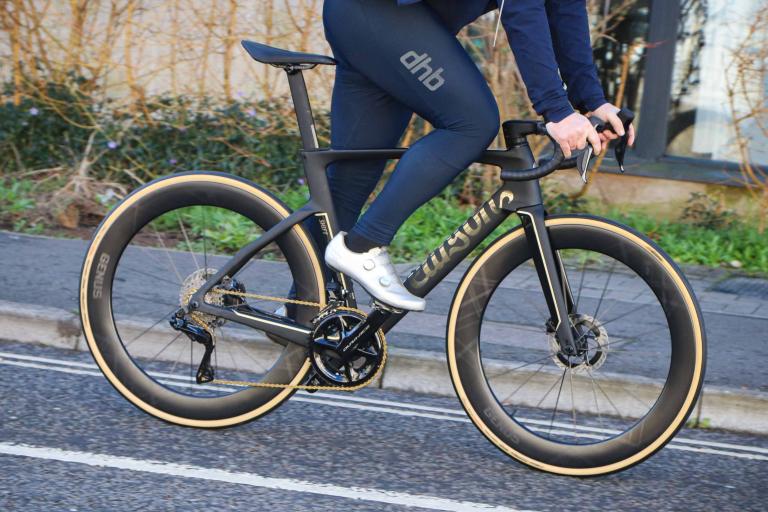
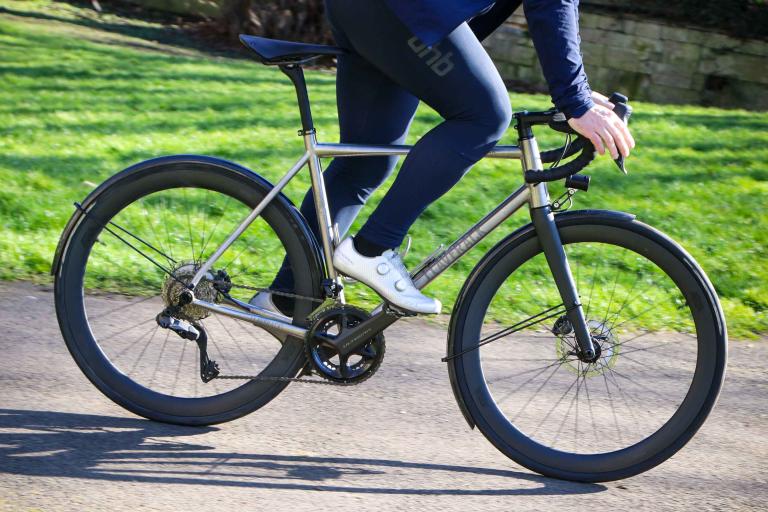
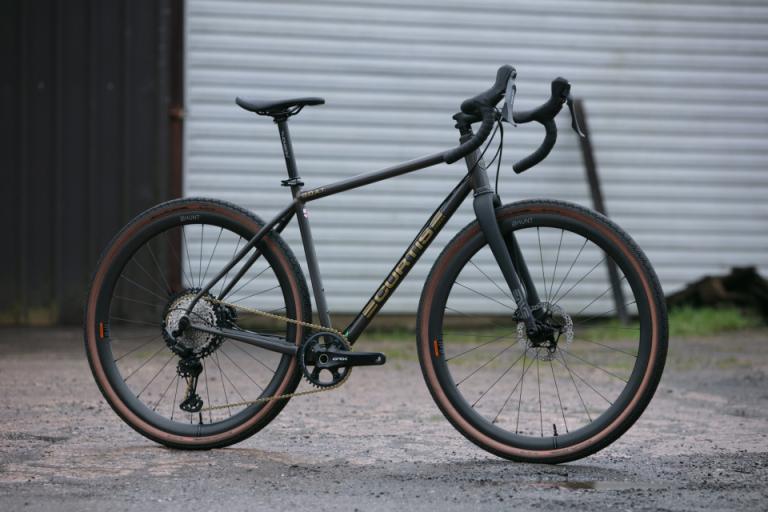
Add new comment
60 comments
Just about any mudguards should be fine (if they're wide enough to suit the tyres you have). So if you're using the standard 35mm tyres then a 45mm SKS Chromoplastic rack (for example) would be fine.
Racks are slightly more complicated as there aren't bosses on the seatstays. You'll need to fit the top mount to the bridge between the seatstays. The Tubus Fly rack is designed specifically to do this, but in reality just about any rack with steel plate brackets to join the top of the rack to the frame will fit, as you can just bend the plate to fit it to the bridge. I generally only bothered bending one of these to suit as this is just for stabilisation rather than weight-bearing.
Just be careful when you're screwing into the bridge between the seatstays - on the test bike, I used too long a screw and the molded-in insert started to pull out.
This would be an alternative to bending to fit the bridge, assuming it's available in the right size.
At the bottom, there are screw-in eyelets which will take the rack and mudguard - make sure they're included when you get the bike.
What rack and mudguards did you fit on this bike when testing? I would like to buy it but Evans Cycles tells me that Jamis Renegade Expert does not take either of those. Both in your review and on Jamis's website it says otherwise though.
Can you recommend the brands that make applicable rear rack and mudguards? I can't find any online that would seem to fit
I saw one of these in Evans today. I don't think there was one square mm without any type of lettering on it.
Hi Jonas,
Sorry for the delayed reply. I have 828mm from BB centre to top of seat (in a straight line), so a bit less than you. I can't honestly remember how much more seat-post there was to be had, I'm afraid. The 58 tested feels like quite a big bike, so you might get away with it.
HTH
Jez
@Jez
Hi,
Excellent review, thank you!
I'm very interested in purchasing this bike and I'm in doubt between size 58 and 61.
May I ask, what is the saddle height you used in testing this bike? I can't quite get a good impression from the 'action photos'.
Looking at the geometry of my current Ridley Noah size XL, it seems like I could pick the 58, but I have a saddle height of 86 cm. My length is 194 cm and inseam 96 cm. I see you're 190 cm...
Can't test because I live in Belgium.
Thank you very much in advance for the help.
Jonas
Can I propose we have a Fugliest Bike of 2015 article? I want this corker be put forward for the top 10!
Might it be that I have just come from here that it looks so wrong now?
Thats why first and very important think we have to look first not only in bikes but in everything we are thinking to buy is aftersale support and warranties.
Personally i prefer best known brands!!! Even with 3 stars
My Renegade was a size 61 and I weigh 210 pounds. I did ride it hard but on not so rough roads and it broke. Jamis blames this on me. So yes something was definitely wrong with mine and I totally own it, but why are they not selling the larger frames.
Review in May but only small size left in stock at Evans. Anywhere else that sells these in the UK?
It's an Evans exclusive, I believe. They told me that they were expecting further stock of the other sizes, but it's worth chasing them up on that.
Re the previous comment about a seat-stay failure - I'd definitely suggest you shouldn't accept that. The test bike has been ridden hard on some pretty rough terrain with no such issues, so it sounds like something isn't right with yours.
I ordered my Renegade Elite 61 in November 2014 after see all the early reviews and that great video. Expecting delivery in January, as advertised, but when March arrived I was told Jamis would not be building any size 61 Elites in 2015. Being persistent my dealer was able to locate a Demo frame size 61 that had not been assembled. We purchased it and built the Elite with all the Shimano Ultegra components. I rode my new bike which I loved the fit and comfort, it was a good ride. But after my third ride in 2 weeks, on rough asphalt and gravel roads (not mountain bike trails), no crashes, not wrecked, never dropped the left seat stay cracked. We sent the frame to Jamis expecting a replacement which was declined. Jamis clams “There is no other way this damage could have appeared on the stay, it could only be caused by upward force being applied to the seat stay and this is not possible during normal riding conditions.” I had three normal rides on a bike that was designed as a ‘heavy duty” adventure bike. So now I’m stuck with a $4000 bike with a broken frame. It maybe the size 61 frame design cannot handle the “heavy duty” label, or the reason Jamis pulled the 61 size Renegade this year and why the Renegade Exploit is come out in 2016 (steel frame). One can only wonder why Jamis can’t seem to support their “high end” product as most other manufactures would and have.
WP_20150502_002.jpg
Don't know about you mate but I'd be taking a trip to the lawyers! Though maybe trading standards could be a first stop under "not fit for purpose".
http://www.tradingstandards.uk/advice/problemswithgoods-sum9.cfm
Rahoodi good stuff mate. Currently the Reynolds assault disc are front runners for me, the thru axle versions land in the UK soon.
And re: gravel/adventure bikes in general- like they say about cameras, the best one is the one you have with you.
interesting.
Any sugestions how it compares to the GT Grade or the Kinesis Tripster ATR?
Fwiw it's worth my 56cm GT Grade carbon is about 9.5kg with pedals, this is after swapping to a carbon handlebar, lighter stem and saddle too.
A friends ATR tripster, built up with enve's and campag in a smaller size felt about the same weight.
I don't see weight as being the all defining metric with these bikes, but it's a metric nonetheless if you want to compare to the Jamis which road.cc quote as weighing 8.7kg for a 58
I was lusting after the GT Grade carbon and the Kinesis Tripster ATR for months but then ruled out the Tripster as I knew I would have spent way too much and test riding would have been a pain. The Jamis also ticked the right boxes for me, a carbon bike with rack/mugaurd mounts, disc brakes etc and I finally got to test ride the Grade and the Jamis a couple of times recently.
The Grade was excellent. Virtually no chatter on concrete and canal paths, exceptionally smooth ride overall with awesome brakes plus it handled singletrack and grass very easily. The Jamis wasnt exceptionally smooth like the Grade but I felt more in control and more planted, more connected to the bike if that makes sense. The ride was still plenty smooth enough with the Clement tyres after i let a little air out and it also handled sharper turns better than the Grade did IMO. The Grade also had more toe overlap but thats a minor thing for me. Both bikes had the grin factor however and both are reasonably priced for what you get. The Jamis (size 54) is around 8.5KG which is a fair bit lighter than the Grade but both felt pretty light to me. The Jamis also felt a bit more robust than the Grade however both bikes felt built for much more than my couple of test rides could give them. Both were pretty stiff and both were fast!
In the end I traded in a kids bike and purchased the Jamis for two grand!
The money I saved not buying the grade I have put towards some lovely carbon Ritchey bars / stem and some 28 tubeless Schwalbe Ones. I am also now considering another set of wheels, one for road and another for everything else but we shall see. You cant really go wrong with either bike if its an adventure road type bike your looking for but the Jamis was the better bike for me. A note on the American classic rims. They dont like Hutchinson tyres, not a problem for me but it may be for some. Also their customer service is fairly pants. Great rims though!
It was a very nice position to be in to have to choose between two awesome bikes but I hope this helps you out.
Despite what I was kind of alluding to above with my question about its suitability for British roads, it does sound like a pretty cool bike. I've got half an eye out for a fast commuter that I could stick a kiddy seat on to take my little boy on adventures. With the rack capabilities this could maybe be a contender.
Don't do the child seat thing, get a weehoo trailer! Best thing we every bought for taking the kids on the bikes. Check ride http://www.rideweehoo.com . Trailer fits kids from age 2 to approx 8.
Jamis looks a great spec, geometry looks sweet but the aesthetics are somewhat overdone. American classics are the least classic looking wheels generally and these keep up that dubious tradition.
But you can't argue with the kit, price and weight.
And to anyone who thinks gravel bikes (with discs brakes) are a solution to a problem that doesn't exist. Try one on your favourite road route, time yourself. I've gone quicker on my GT grade on club runs, uphill and downhill, than on my 2 kg lighter road bike fitted with aero wheels that are themselves more expensive than the Grade. I'm not saying it's faster per se, but it's not a handicap.
Plus I can go off-road on it when I'm cycling with my young daughter. Very handy for family holidays when you want to sneak a proper road ride in. Yesterday I was in muddy fields, today I rode half the Dragon route faster than on my road bike during last year's event. Fold in winter training/mudguard abilities and commuting and it's a win win.
That paint scheme is a bit of a mess. The Renegade would look much nicer if it was blue. Or black.
Other than that, very tempting!
Jez
I see you also own my bike the boardman CX team, I have to say I've loved owning this bike and it has never failed to put a smile on my face. I've done the C2C on it as well as the south downs way and clocked up many many miles on the bridal ways near to me.
I also own a carbon Giant xtc which I have used very little primarily as the boardman just makes so much more sense, it has a rack permanently on it as I like to take my cameras whenever i go riding. The upshot of this is the giant is for sale and I intend to splash some dollar on my one and only bike.
Here's the problem, prior to reading this review I had decided on the kinesis tripster, with a faint possibility of the Niner RLT 9 STEEL 2-STAR 105. Now I am in a quandary a pleasant one yes, but still a fix, given your boardman ownership of those I have listed which would you recommend?
One of the biggest pains of course is the complete lack of being able to test ride them, I have never understood the cycle industry, here's a product which is serious money and can you go ride one !!!
Want to take a car out sir ? 911, not a problem when would you like to come? The same for my motorbike had the BMW s1000r for a day not a problem, yep I had to cover the excess if I bent it, but hell not a problem.
So Jez what say you?
@124g maybe because cars and motorbikes vary by model but not sizes? Evans offer test rides on their stock for a £100 deposit. I test rode (and bought) a GT Grade with them.
(I also test rode a BMW s100RR, with no deposit necessary!)
Also afaik kinesis don't offer complete tripster builds, just a build kit.
Hello 124g. Sorry for slow reply, was in hospital after a bad bike crash (not on the Jamis). Dave's still running the Tripster ATR and he loves it. It's a great bike and would be a decent choice. It depends what your priorities are, I think.
I liked my Boardman (now stripped and on its way out) but the Jamis knocks it out the park. You can really feel the lower weight and off-road it was a revelation, as I mentioned. Ridiculously good spec for the money, too.
If your usage profile is more road based with an eye on long-haul riding, then maybe the ATR is a better option, but if you want a lighter-weight bike which can keep a hardtail MTB honest on a lot of off-road stuff, the Jamis is hard to beat. I've not ridden the Niner, but I know Iwein (another road.cc reviewer) loves his Niner mtb. The RLT9 is certainly a beautiful bike.
I'd guess both the Niner and the ATR would be more expensive?
So is the reviewer suggesting this is better than the GT Grade, Kinesis Tripster ATR, Argon 18 Krypton X Road or Niner RLT Steel?
What a great bike, I hope it sells in huge amounts. Just one question, how is the front derailleur mounted to the frame? its looks rivetted
Super looking bike.. If only Evans had actually any stock of the larger sizes. Nothing in 58 and 61 is just a day dream....
It is really nice but I would not like to take a carbon bike off road particularly, also doesn't have that added versatility of rack and mudguard mounts - so not really touring potential. I had this argument in my head last year and went for the steel Kona Rove in the end, yep is pretty heavy (but so am I!), but it is pretty fast, bomb proof, comfy and very versatile - oh and a lot cheaper! I do have a carbon road bike for proper fast road days (and it is lovely to treat myself to the carbon bike speed after the Rove) - the Rove does everything else.
Errr, it has both rack mounts and mudguard mounts - you're just looking at the pictures!
Absolutely, I think they just sort of explode or something.... maybe one day when someone's actually taken one off-road and survived - until then, i'm not going to be the guinea pig for sort of foolishness.
erm, right, why? Plenty of carbon MTBs being ridden off road with no problems.
Carbon is not as brittle as you might think (or once was), or at least good carbon frames aren't. Good carbon frame manufacturers put a protective layer of carbon on key areas of a carbon frame to protect from stone stikes or other knocks. Such frames are no easier to damage than most aluminium frames, meaning for the most part it will only be cosmetic.
Pages